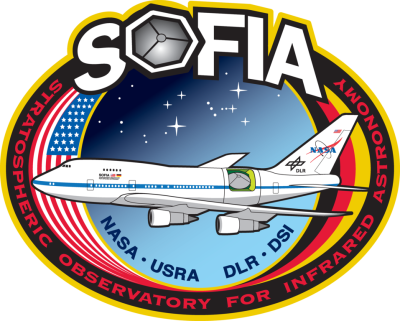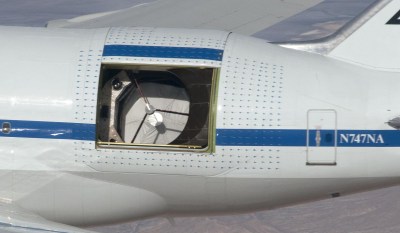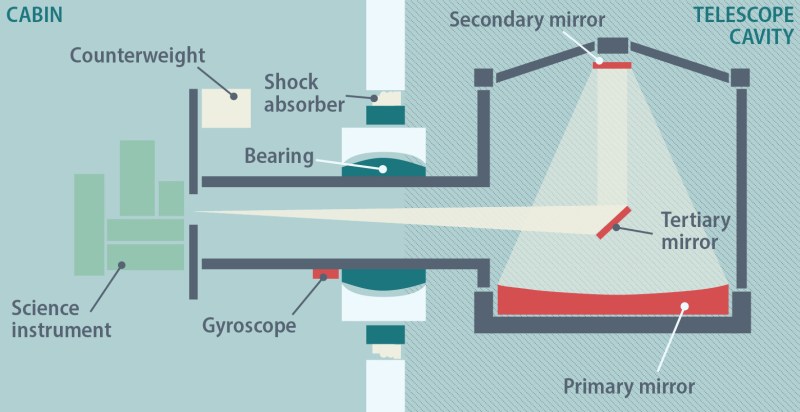NASA’s Hubble Space Telescope is arguably the best known and most successful observatory in history, delivering unprecedented images that have tantalized the public and astronomers alike for more than 30 years. But even so, there’s nothing particularly special about Hubble. Ultimately it’s just a large optical telescope which has the benefit of being in space rather than on Earth’s surface. In fact, it’s long been believed that Hubble is not dissimilar from contemporary spy satellites operated by the National Reconnaissance Office — it’s just pointed in a different direction.
 There are however some truly unique instruments in NASA’s observational arsenal, and though they might not have the name recognition of the Hubble or James Webb Space Telescopes, they still represent incredible feats of engineering. This is perhaps best exemplified by the Stratospheric Observatory for Infrared Astronomy (SOFIA), an airborne infrared telescope built into a retired airliner that is truly one-of-a-kind.
There are however some truly unique instruments in NASA’s observational arsenal, and though they might not have the name recognition of the Hubble or James Webb Space Telescopes, they still represent incredible feats of engineering. This is perhaps best exemplified by the Stratospheric Observatory for Infrared Astronomy (SOFIA), an airborne infrared telescope built into a retired airliner that is truly one-of-a-kind.
Unfortunately this unique aerial telescope also happens to be exceptionally expensive to operate; with an annual operating cost of approximately $85 million, it’s one of the agency’s most expensive ongoing astrophysics missions. After twelve years of observations, NASA and their partners at the German Aerospace Center have decided to end the SOFIA program after its current mission concludes in September.
With the telescope so close to making its final observations, it seems a good time to look back at this incredible program and why the US and German space centers decided it was time to put SOFIA back in the hangar.
Eye In the Sky
By making its astronomical observations while flying through the stratosphere at an altitude of approximately twelve kilometers (40,000 feet), SOFIA is literally and figuratively a middle ground between ground and space based telescopes. Its operational altitude means the telescope is above the vast majority of atmospheric water vapor that would otherwise block certain infrared frequencies from reaching the Earth’s surface, while its ability to be regularly serviced and upgraded gives it the sort of scientific flexibility that would normally be associated with an observatory on the ground.
 The key to the SOFIA program is an aircraft large enough to carry the telescope, along with its instrumentation and the personnel to operate it, up to the required altitude for stable, long-duration flights. In this case, it’s a Boeing 747SP wide-body airliner that originally started its career with Pan Am back in 1977.
The key to the SOFIA program is an aircraft large enough to carry the telescope, along with its instrumentation and the personnel to operate it, up to the required altitude for stable, long-duration flights. In this case, it’s a Boeing 747SP wide-body airliner that originally started its career with Pan Am back in 1977.
This special “SP” variant of the iconic 747 was specifically engineered to fly longer, faster, and higher by removing a section of the fuselage and performing other mass-saving modifications. Built in relatively limited numbers specifically for flights between New York and the Middle East, the airframe used for SOFIA is one of only four 747SPs still flying.
Considerable structural modifications were required for the 747SP to carry the 17 metric ton (38,000 lbs) telescope, but certainly none more obvious than the large door that can be opened during flight to expose the 2.7 m (8.8 ft) primary mirror. To prevent an inrush of wind when the door is open, which would introduce unacceptable vibrations in the optics, a pronounced “hump” was added to the rear of the fuselage to redirect the high-speed airflow before it hits the opening. Some turbulent air does invariably enter the chamber, but it can be compensated for using the telescope’s mount, which uses a combination of pressurized oil bearings, counterweights, gyroscopes, and magnetic torque motors to stabilize and aim the instrument.
Powerful Competition
The SOFIA telescope is by far the largest ever to be mounted in an aircraft, a record which will almost certainly never be broken. Even still, its primary mirror is dwarfed by the 6.5 m (21 ft) reflector of the James Webb Space Telescope (JWST), NASA’s new flagship infrared telescope that is just days away from coming online. While it’s difficult to directly compare the two observatories and their capabilities, there’s no question that the JWST represents the future of infrared astronomy. At the same time, SOFIA has faced criticism over the last few years over how little scientific data it has been able to collect relative to its high development and operational costs.
While the JWST largely makes SOFIA redundant, that’s not to say the scientific community won’t mourn its loss. Not only is SOFIA capable of observing a much wider range of IR frequencies, but its unique ability to target the moon led directly to the 2020 confirmation of water on the sunlit lunar surface. It can also be upgraded over time to make observations with instruments that today might not even exist, whereas the JWST is too far from Earth to ever receive the sort of incremental upgrades that Hubble did.
Put simply, there’s a valid need for an observatory like SOFIA. But unless NASA can figure out a cheaper way to build and operate one, it might be a scientific niche that goes unfulfilled.

















Marcus on the OmegaTau podcast had a good deep dive episode about SOFIA. He actually rode on one of the missions, and had a great chat with some of the scientists involved.
Good listening:
https://omegataupodcast.net/touren-tours/sofia/
“JWST is too far from Earth to ever receive the sort of incremental upgrades that Hubble did.”
Given the decreasing cost and growing lift capability, we might just send improved replacements once a decade. However, I do ponder how they plan to ultimately remove JWST from the L2 point.
“we might just send improved replacements once a decade.”
There’s exactly one way you make a significantly better version of JWST: make it bigger. Just about everything on it is at or very near its practical theoretical best performance. And the difficulty in making a bigger JWST has very little to do with the launch capabilities.
Even just building another exact copy of JWST would take quite a lot of time and money.
“However, I do ponder how they plan to ultimately remove JWST from the L2 point.”
L2 is an unstable Lagrange point (which is fantastic for telescopes – stable points are garbage dumps). It can be “removed” from L2 by the absolute slightest push – it takes fuel to stay there.
Seems to me you could park half a dozen hundred inch telescopes on half a dozen 20,000 ft mountains and operate them 10 years as a synthetic aperture superscope for around the single year cost of running this. That depends on how legal it still is to use post grads as slave labor of course :-D
Hey if you don’t want to freeze your ass while suffering hypoxia you should have gone into theoretical physics!
“Seems to me you could park half a dozen hundred inch telescopes on half a dozen 20,000 ft mountains and operate them 10 years as a synthetic aperture superscope for around the single year cost”
You wouldn’t be able to build a single observatory in any of those locations for $80M+, much less multiple. And there’d be quite a lot more atmosphere than what this sees.
No context to work out if $85m is good or bad money for owning & operating a Boeing 747 + a pretty rad telescope for a year. Anyone got any?
If you could rent a drone with a camera and operator at $85 per flight hour and this was 1000x bigger and did 1000 flight hours? Alternatively, half that and the boss crashes a dozen Bugatti Veyrons a year.
The operating cost isn’t really that high in comparison to a space-based observatory: the issue is that the science output isn’t good and it’s a bit of a unicorn – it doesn’t really use any common NASA resources or infrastructure (partly why its cost is as high as it is relative to other missions).
NASA’s really never been high on SOFIA (unsurprising, see above), and they’ve been trying to get rid of it for several years. It keeps getting funding explicitly restored to it by Congress.
We went aboard SOFIA for a school visit. One of the funny things is that they have to fly in circles to keep the telescope pointed in the same direction.
Its down here in Christchurch, NZ where I live, as I type this. Will be sad not to have our regular visitor anymore! :-(
I visited an ESA conference on balloon and rocket science earlier this year and met some people who want to put ‘the next SOFIA’ on a stratospheric balloon instead. It’s supposed to fly over the arctic for two weeks each year and as absurd as it sounds I think that’s a really promising idea! Can’t really get better atmospheric disturbances short of going to space, but there simply won’t be any funding for space telescopes in the next 15 – 20 years.
There are of course a lot of issues, one of which is stabilizing this delicate piece of hardware on a freaking balloon, but they already ordered some really hefty reaction wheels. I’m definitely excited about this, even if it turns out to be a failure.
If anyone is interested:
https://www.researchgate.net/publication/358488250_Stratospheric_balloons_as_a_platform_for_the_next_large_far_infrared_observatory
Balloon-based telescopes aren’t that uncommon and it’s *definitely* preferable from a NASA standpoint since it uses common resources. There’s a documentary from 2008 (called BLAST!) if you want to see more of what that kind of launch entails.